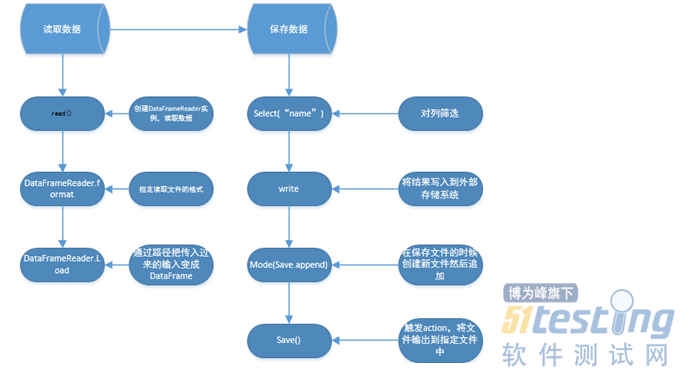3. 在保持文件的时候mode指定追加文件的方式
/**
* Specifies the behavior when data or table already exists. Options include:
// Overwrite是覆盖
* - `SaveMode.Overwrite`: overwrite the existing data.
//创建新的文件,然后追加
* - `SaveMode.Append`: append the data.
* - `SaveMode.Ignore`: ignore the operation (i.e. no-op).
* - `SaveMode.ErrorIfExists`: default option, throw an exception at runtime.
*
* @since 1.4.0
*/
def mode(saveMode: SaveMode): DataFrameWriter = {
this.mode = saveMode
this
}
4. 最后,save()方法触发action,将文件输出到指定文件中。
/**
* Saves the content of the [[DataFrame]] at the specified path.
*
* @since 1.4.0
*/
def save(path: String): Unit = {
this.extraOptions += ("path" -> path)
save()
}
三:Spark SQL读写整个流程图如下:
四:对于流程中部分函数源码详解:
DataFrameReader.Load()
1. Load()返回DataFrame类型的数据集合,使用的数据是从默认的路径读取。
/**
* Returns the dataset stored at path as a DataFrame,
* using the default data source configured by spark.sql.sources.default.
*
* @group genericdata
* @deprecated As of 1.4.0, replaced by `read().load(path)`. This will be removed in Spark 2.0.
*/
@deprecated("Use read.load(path). This will be removed in Spark 2.0.", "1.4.0")
def load(path: String): DataFrame = {
//此时的read就是DataFrameReader
read.load(path)
}
2. 追踪load源码进去,源码如下:
在DataFrameReader中的方法。Load()通过路径把输入传进来变成一个DataFrame。
/**
* Loads input in as a [[DataFrame]], for data sources that require a path (e.g. data backed by
* a local or distributed file system).
*
* @since 1.4.0
*/
// TODO: Remove this one in Spark 2.0.
def load(path: String): DataFrame = {
option("path", path).load()
}
3. 追踪load源码如下:
/** * Loads input in as a [[DataFrame]], for data sources that don't require a path (e.g. external * key-value stores). * * @since 1.4.0 */ def load(): DataFrame = { //对传入的Source进行解析 val resolved = ResolvedDataSource( sqlContext, userSpecifiedSchema = userSpecifiedSchema, partitionColumns = Array.empty[String], provider = source, options = extraOptions.toMap) DataFrame(sqlContext, LogicalRelation(resolved.relation)) } |
DataFrameReader.format()
1. Format:具体指定文件格式,这就获得一个巨大的启示是:如果是Json文件格式可以保持为Parquet等此类操作。
Spark SQL在读取文件的时候可以指定读取文件的类型。例如,Json,Parquet.
/**
* Specifies the input data source format.Built-in options include “parquet”,”json”,etc.
*
* @since 1.4.0
*/
def format(source: String): DataFrameReader = {
this.source = source //FileType
this
}
DataFrame.write()
1. 创建DataFrameWriter实例
/**
* :: Experimental ::
* Interface for saving the content of the [[DataFrame]] out into external storage.
*
* @group output
* @since 1.4.0
*/
@Experimental
def write: DataFrameWriter = new DataFrameWriter(this)
2. 追踪DataFrameWriter源码如下:
以DataFrame的方式向外部存储系统中写入数据。
/**
* :: Experimental ::
* Interface used to write a [[DataFrame]] to external storage systems (e.g. file systems,
* key-value stores, etc). Use [[DataFrame.write]] to access this.
*
* @since 1.4.0
*/
@Experimental
final class DataFrameWriter private[sql](df: DataFrame) {
DataFrameWriter.mode()
1. Overwrite是覆盖,之前写的数据全都被覆盖了。
Append:是追加,对于普通文件是在一个文件中进行追加,但是对于parquet格式的文件则创建新的文件进行追加。
** * Specifies the behavior when data or table already exists. Options include: * - `SaveMode.Overwrite`: overwrite the existing data. * - `SaveMode.Append`: append the data. * - `SaveMode.Ignore`: ignore the operation (i.e. no-op). //默认操作 * - `SaveMode.ErrorIfExists`: default option, throw an exception at runtime. * * @since 1.4.0 */ def mode(saveMode: SaveMode): DataFrameWriter = { this.mode = saveMode this } |
2. 通过模式匹配接收外部参数
/** * Specifies the behavior when data or table already exists. Options include: * - `overwrite`: overwrite the existing data. * - `append`: append the data. * - `ignore`: ignore the operation (i.e. no-op). * - `error`: default option, throw an exception at runtime. * * @since 1.4.0 */ def mode(saveMode: String): DataFrameWriter = { this.mode = saveMode.toLowerCase match { case "overwrite" => SaveMode.Overwrite case "append" => SaveMode.Append case "ignore" => SaveMode.Ignore case "error" | "default" => SaveMode.ErrorIfExists case _ => throw new IllegalArgumentException(s"Unknown save mode: $saveMode. " + "Accepted modes are 'overwrite', 'append', 'ignore', 'error'.") } this } |
DataFrameWriter.save()
1. save将结果保存传入的路径。
/**
* Saves the content of the [[DataFrame]] at the specified path.
*
* @since 1.4.0
*/
def save(path: String): Unit = {
this.extraOptions += ("path" -> path)
save()
}
2. 追踪save方法。
/** *Savesthecontentofthe[[DataFrame]]asthespecifiedtable. * *@since1.4.0 */ defsave():Unit={ ResolvedDataSource( df.sqlContext, source, partitioningColumns.map(_.toArray).getOrElse(Array.empty[String]), mode, extraOptions.toMap, df) } |
3. 其中source是SQLConf的defaultDataSourceName
private var source: String = df.sqlContext.conf.defaultDataSourceName
其中DEFAULT_DATA_SOURCE_NAME默认参数是parquet。
// This is used to set the default data source
val DEFAULT_DATA_SOURCE_NAME = stringConf("spark.sql.sources.default",
defaultValue = Some("org.apache.spark.sql.parquet"),
doc = "The default data source to use in input/output.")
DataFrame.Scala中部分函数详解:
1. toDF函数是将RDD转换成DataFrame
** * Returns the object itself. * @group basic * @since 1.3.0 */ // This is declared with parentheses to prevent the Scala compiler from treating // `rdd.toDF("1")` as invoking this toDF and then apply on the returned DataFrame. def toDF(): DataFrame = this |
2. show()方法:将结果显示出来
/** * Displays the [[DataFrame]] in a tabular form. For example: * {{{ * year month AVG('Adj Close) MAX('Adj Close) * 1980 12 0.503218 0.595103 * 1981 01 0.523289 0.570307 * 1982 02 0.436504 0.475256 * 1983 03 0.410516 0.442194 * 1984 04 0.450090 0.483521 * }}} * @param numRows Number of rows to show * @param truncate Whether truncate long strings. If true, strings more than 20 characters will * be truncated and all cells will be aligned right * * @group action * @since 1.5.0 */ // scalastyle:off println def show(numRows: Int, truncate: Boolean): Unit = println(showString(numRows, truncate)) // scalastyle:on println |
追踪showString源码如下:showString中触发action收集数据。
/**
* Compose the string representing rows for output
* @param _numRows Number of rows to show
* @param truncate Whether truncate long strings and align cells right
*/
private[sql] def showString(_numRows: Int, truncate: Boolean = true): String = {
val numRows = _numRows.max(0)
val sb = new StringBuilder
val takeResult = take(numRows + 1)
val hasMoreData = takeResult.length > numRows
val data = takeResult.take(numRows)
val numCols = schema.fieldNames.length
















